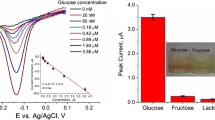Abstract
A new data-processing method was established and applied for optical enzymatic glucose sensing, in which oxygen and glucose were simultaneously consumed. The oxygen level remaining in the detection system, which was equal to the difference between the initial and consumed oxygen concentrations, could be measured using fluorescent oxygen indicators immobilized in the sensing layer. It was deduced that the ratio of I 0 and I was inversely proportional to glucose concentration, where I 0 is the maximum fluorescence intensity in various glucose solutions, and I is the fluorescence intensity at various concentrations of glucose. Using the new data-processing method, the detection range of the calibration curve method was extended from 0 to 1.2 mmol L−1, which was enlarged about 2–3 folds over that in ordinary approaches. The prepared glucose sensor could be directly applied to detect high concentrations of glucose.
Similar content being viewed by others
References
Heller A, Feldman B. Electrochemical glucose sensors and their applications in diabetes management. Chem Rev, 2008, 108: 2482–2505
Scognamiglio V, Staiano M, Rossi M, D’Auria S. Protein-based biosensors for diabetic patients. J Fluoresc, 2004, 14: 491–498
Reach G, Wilson GS. Can continuous glucose monitoring be used for the treatment of diabetes? Anal Chem, 1992, 64: 381A–386A
Park S, Boo H, Chung TD. Electrochemical non-enzymatic glucose sensors. Anal Chim Acta, 2006, 556: 46–57
Wang J. Electrochemical glucose biosensors. Chem Rev, 2008, 108: 814–825
Borisov SM, Wolfbeis OS. Optical biosensors. Chem Rev, 2008, 108: 423–461
Moreno-Bondi MC, Wolfbeis OS, Leiner MJP, Schaffar BPH. Oxygen optrode for use in a fiber-optic glucose biosensor. Anal Chem, 1990, 62: 2377–2380
Wolfbeis OS. Fiber-optic chemical sensors and biosensors. Anal Chem, 2008, 80: 4269–4283
Fang H, Kaur G, Wang B. Progress in boronic acid-based fluorescent glucose sensors. J Fluoresc, 2004, 14: 481–489
Clark LC, Lyons C. Electrode systems for continuous monitoring in cardiovascular surgery. Ann N Y Acad Sci, 1962, 102: 29–45
Yang X, Zhou Z, Xiao D, Choi MMF. A fluorescent glucose biosensor based on immobilized glucose oxidase on bamboo inner shell membrane. Biosens Bioelectron, 2006, 21: 1613–1620
Scully PJ, Betancor L, Bolyo J, Dzyadevych S, Guisan JM, Fernández-Lafuente R, Jaffrezic-Renault N, Kuncová G, Matějec V, O’Kennedy B, Podrazky O, Rose K, Sasek L, Young JS. Optical fibre biosensors using enzymatic transducers to monitor glucose. Meas Sci Technol, 2007, 18: 3177–3186
Manesh KM, Santhosh P, Gopalan A, Lee K. Electrospun poly(vinylidene Xuoride)/poly(aminophenylboronic acid) composite nano Wbrous membrane as a novel glucose sensor. Anal Biochem, 2007, 360: 189–195
Yamazaki T, Kojima K, Sode K. Extended-range glucose sensor employing engineered glucose dehydrogenases. Anal Chem, 2000, 72: 4689–4693
Wolfbeis OS, Oehme I, Papkovskaya N, Klimant I. Sol-gel based glucose biosensors employing optical oxygen transducers, and a method for compensating for variable oxygen background. Biosens Bioelectron, 2000, 15: 69–76
Wolfbeis OS, Schäferling M, Dürkop A. Reversible optical sensor membrane for hydrogen peroxide using an immobilized fluorescent probe, and its application to a glucose biosensor. Microchim Acta, 2003, 143: 221–227
Wang X, Zhou T, Chen X, Wong K, Wang X. An optical biosensor for the rapid determination of glucose in human serum. Sens Actuators B, 2008, 129: 866–873
Lin L, Xiao L, Huang S, Zhao L, Cui J, Wang X, Chen X. Novel BOD optical fiber biosensor based on co-immobilized microorganisms in ormosils matrix. Biosens Bioelectron, 2006, 21: 1703–1709
Wang X, Chen X, Xie Z, Wang X. Reversible optical sensor strip for oxygen. Angew Chem Int Ed, 2008, 47: 7450–7453
Author information
Authors and Affiliations
Corresponding author
Rights and permissions
About this article
Cite this article
Guo, G., Wang, X., Zhou, T. et al. Extended detection range for an optical enzymatic glucose sensor coupling with a novel data-processing method. Sci. China Chem. 53, 1385–1390 (2010). https://doi.org/10.1007/s11426-010-3161-6
Received:
Accepted:
Published:
Issue Date:
DOI: https://doi.org/10.1007/s11426-010-3161-6




